
Wild Lettuce
Wild Lettuce (Lactuca Virosa) is, as the name suggests, a member of the lettuce genus, but it is not likely to be used in most people’s salads for several reasons. Rather, the sap, leaves, and seeds are used to make medicines.
Common names for this plant include bitter lettuce, opium lettuce, poisonous lettuce, wild salad, and tall or great lettuce. Some of these hint at both uses and potential disadvantages – even dangers – of this cousin of the common lettuce.
The History Of Wild Lettuce
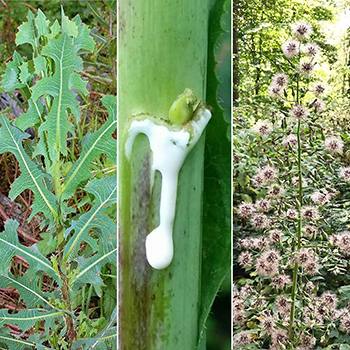 This plant has been utilized medicinally for almost 2,500 years when the Ancient Greeks used the sap obtained from Wild Lettuce for pain relief. We know it had reached North America at the time of the Civil War as medical staff used the plant as an analgesic when liquid opium was difficult to obtain.
This plant has been utilized medicinally for almost 2,500 years when the Ancient Greeks used the sap obtained from Wild Lettuce for pain relief. We know it had reached North America at the time of the Civil War as medical staff used the plant as an analgesic when liquid opium was difficult to obtain.
Around the same time in Europe, individuals in Poland noted that – despite the opioid effects of this plant’s sap – it had none of the addictive properties. This added to the medicinal value of Lactuca Virosa.
In the middle of the last century, the so-called hippie communities began to use it as a legal way to get high although the psychoactive properties of the plant are mild. Today Wild Lettuce is again popular with herbalists and homeopaths who use it for a range of remedies targeting several ailments.
Where This Plant Is Found
Wild Lettuce is thought to be native to parts of North America, the Middle East, central and southern Europe, and most of the UK. It has been introduced beyond its range to Australia and parts of India and Pakistan. It grows wild in all these regions.
Related: The Complete Map of Edible Plants: Find Out What You Have in Your Area! (Video)
How to Identify Wild Lettuce
As the name indicates, this plant is related to the lettuce most of us are familiar with and would include in salads, etc. However, it does not look or grow, like your usual salad lettuce. Firstly, this plant takes two years to complete its lifecycle. Secondly, can reach a height of 6.6 feet / 2 meters although half that size is more common. 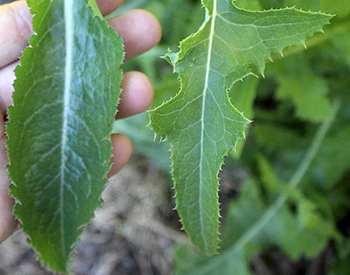
- Leaf: The leaves are grey-green, oval, and broad with jagged edges. There are spines along the edges of the leaves and the central vein or midrib on the underside of the leaf. These spines down the center of the underside are one of the best ways to identify Lactuca Virosa. The base of each leaf is wrapped around the stem rather than attached by a smaller stem or a stalk.
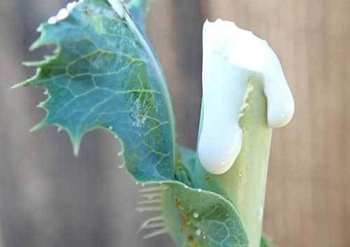
- Stalk/stem: The stem is green and may have reddish or purplish marks and be covered in short spikes that are green, purple, or red. It is also not a rigid or fibrous stem and is easy to pierce and cut.
- Sap: The sap oozes from cuts in the stalks. It is white/milky and sticky and offers medicinal properties.

- Flower: The buds form in clusters and have tiny purple marks on them.
The flowers are small and yellow and look almost identical to those of the dandelion.
The individual flowers sometimes have a faint purple tinge at the edge and underside of the petals.
Flowers also only open in the morning and at midday when the sunlight is at its brightest.
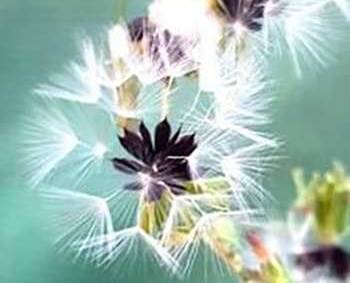
- Seeds: Like the flowers, the seeds of the Wild Lettuce resemble those of the dandelion.
There is a large black seed that has a white tuft attached to aid seed dispersal.
The taste of Lactuca Virosa leaves is quite bitter.
Before you ate them raw you would need to remove the spikes!
How To Grow Wild Lettuce
Wild Lettuce grows readily from seed. These should be sown in spring or fall and either in pots or directly into your garden.
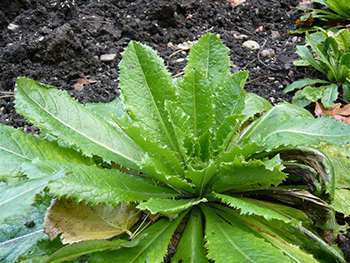 Prepare the soil so that it has been turned. It is not necessary to use fertilizer or compost, but some gardeners believe plants get a better head start if you do. Make a shallow depression in the soil and drop in the seeds, keeping them separate if possible. Cover the seeds lightly with soil and pat it down gently.
Prepare the soil so that it has been turned. It is not necessary to use fertilizer or compost, but some gardeners believe plants get a better head start if you do. Make a shallow depression in the soil and drop in the seeds, keeping them separate if possible. Cover the seeds lightly with soil and pat it down gently.
The seeds will need enough water to keep them moist and sunlight to germinate. Shoots should appear after 10 – 20 days. Once the seedlings are big enough, transplant them so that they are approximately 6 inches / 15 centimeters apart. This gives the plants enough space to grow without crowding each other.
How To Harvest And Process This Plant
The plant is considered most potent when it is in bloom, but you can harvest it earlier.
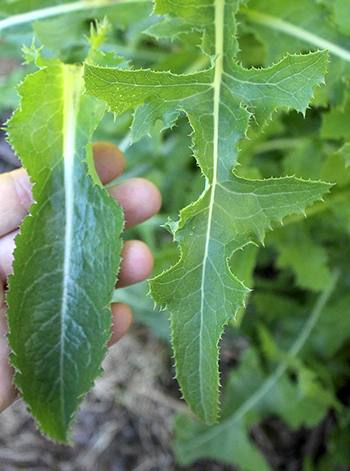
- Harvesting leaves is straightforward, but wear gloves as the little spines on the leaves and stems can be a nuisance:
- Remove the leaves or cutting whole stalks
- Strip the leaves from the stalks
- If you want to use the fresh leaves, remove the leaf spines, especially the ones on the underside
- Wash the leaves to remove debris and loose spines
- To dry them for tea, spread the leaves out on a rack or cloth in a warm, well-ventilated area but away from direct sunlight
- Once thoroughly dry place the leaves in labeled airtight containers.
The Collection Of Sap
The collection of sap is more complex and varies depending on which method you favor:
The (very time-consuming) traditional method: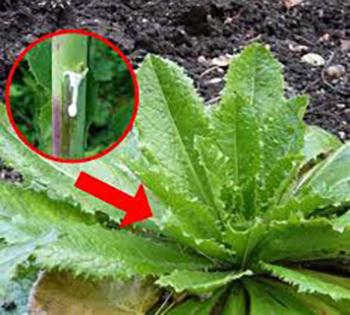
- Cut an inch off the top of the stalk and allow the sap to ooze out
- Scrape off the sap and place it in a bowl
- Repeat the process until you reach the base of the stalk.
The (quicker) modern method:
- Sever the stalks at ground level or pull them out roots and all
- Remove the flowers and strip the leaves from the stalks
- Chop the stalks into 1 inch / 2 ½ cm long pieces and lengthwise
- Cook on medium heat until the liquid browns, strains, and recook – stirring regularly – until it thickens.
The traditionalists believe that the sap needs time to form slowly and naturally after each cut as it is only through this process that the plant releases all the active compounds you want.
What Wild Lettuce Is Good For And The Natural Remedies Made From It
Based on anecdotal evidence rather than strong clinical evidence, Lactuca Virosa is useful to ease or treat a range of health issues including: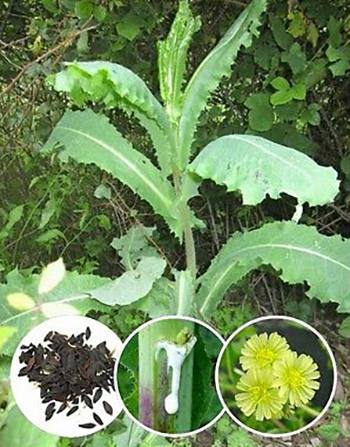
- Pain relief for headaches, minor injuries, arthritis, and menstrual discomfort
- Urinary tract infections and edema (acts as a diuretic)
- Insomnia
- Anxiety
- Restlessness and hyperactivity
- Coughs and tight chest and asthma
There are several forms of Wild Lettuce herbal or natural remedies or products: tea, tincture, and powder (available as a loose powder or in capsule form). Which one you make or buy depends on what you want to use it for.
What Parts Of The Plant Are Used In Remedies?
The primary medicinal plant material obtained from Wild Lettuce is the sap which is obtained from the stalks.
However, the leaves are also used in several preparations including teas and tinctures.
A DIY Wild Lettuce Recipe
A popular way of ingesting Wild Lettuce for use for several health issues is in the form of a tincture. Here is an easy recipe:
Ingredients
- Fresh Wild Lettuce leaves
- Vodka (80% proof or higher)
Method
- Harvest fresh leaves and tender stems.
- Chop the plant material up roughly into small pieces.
- Place the Wild Lettuce in a blender.
- Blend the leaves on slow until they form a green paste.
- Pour the paste into a suitable glass jar until it is about 1/3 full.
- Add vodka so you have a 2:1 ratio / twice as much alcohol as plant paste.
- Place a secure lid and a label on the jar.
- Store the jar in a cool, dark area for 6 weeks.
- Strain the tincture using cheesecloth or kitchen muslin.
- Store the strained tincture in a labeled bottle or jar.
The alcohol helps to preserve the mixture. Most tinctures of this sort have a shelf-life of up to a year. However, if you notice a change in the smell or color of the tincture, you should probably get rid of it.
Dosage
As with most remedies, including herbal ones, how much you can safely use depends on several factors:
- Why you are using the remedy
- Your overall state of health
- Your age may be a factor
- What medications you are currently on
- Any medical conditions you suffer from.
Because of the extremely limited number of clinical studies, there is currently little scientific data about Wild Lettuce doses. The best advice is that you follow the instructions provided by your healthcare provider and/or the product manufacturer.
What Plants Resemble Wild Lettuce?
There are a few plants that are sometimes mistaken for Wild Lettuce. Fortunately, none are toxic, and one – Prickly Lettuce – in fact, has similar properties to its Wild cousin. Comparing these plants may help you to correctly identify them.
| Feature | Wild Lettuce Lactuca Virosa | Prickly Lettuce Lactuca serriola | Prickly Sow Thistle Sonchus asper |
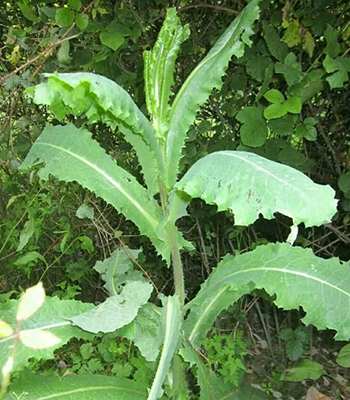 |
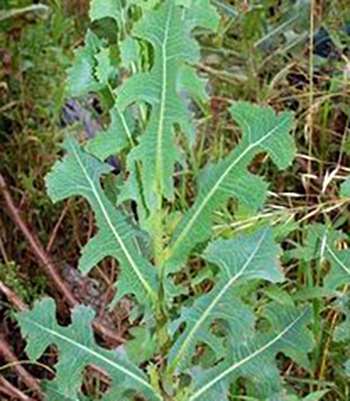 |
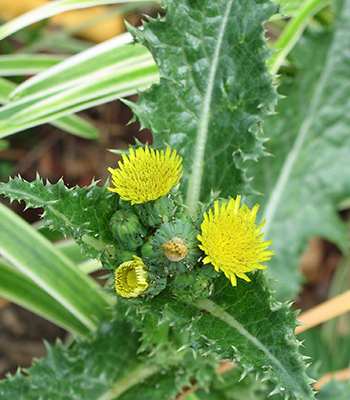 | |
| Size | Up to 6.6 feet / 2 m but usually 3 feet / 1 meters in height | Up to 6.6 feet / 2 m but usually 3 feet / 1 meters in height | Up to 5 feet / 1 ½ m in height |
| Leaves | Grey-green, oval, broad, jagged edges with spines, spines along the midrib on the underside of the leaf | Grey-green, lobed, deeply serrated edges, spines along veins and leaf edges not on the midrib on the underside | Blue-green, shiny, lanceolate, very spiny on the edges and both leaf surfaces |
| Stem / stalk | Green, reddish/purplish marks, may have short green/purple/red spikes | Spineless reddish stem, slightly woody | Hairless except on upper stem, reddish, angled, sometimes branched |
| Flowers | Clusters, small, yellow, may have faint purple tinge at the edge and underside | Clusters, small, yellow, may have a faint purple tinge at the edge and underside | Yellow rays, flat-topped arrays not clusters |
| Seeds | Oblong black seed that has a white tuft | Long, grooved brown seed with a white tuft | Pear-shaped, grooved brown seed with a white tuft |
| Sap | Yes, from leaves and stems | Yes, from leaves and stems | Yes, from leaves and stems |
| Edible | Yes | Yes, but may cause health problems in cattle | Yes |
Using these points of comparison – particularly the differences in leaf shape and spine distribution – should help to avoid identification errors. However, if you are ever unsure about a plant err on the side of caution and do not handle or ingest it!
Warning And Cautions
The studies that have been done do, unfortunately, indicate that there is a great deal about the side effects and potential dangers of Wild Lettuce that we do not yet know. It does appear to be the case that taking too much of this plant, or too often, can have unpleasant or dangerous side effects. These include slowed breathing, nausea and vomiting, dizziness, agitation, and blurred vision.
Pregnant and breastfeeding women or individuals who are taking diuretics, sedatives, or suffer from any psychiatric conditions should not use Wild Lettuce. There is also a possibility that some people may suffer an allergic reaction.
However, many individuals balance these potential dangers against the fact that there is anecdotal evidence of health benefits without serious harm that stretches over millennia.
The important rule of thumb is not to use Wild Lettuce in any form without first consulting your healthcare practitioner, especially if you have a medical condition or taking medication.
You may also like:
20 Edible And Medicinal Plants You Can Forage In March
Add These Medicinal Seeds To Your Backyard (Video)
How To Make A Pain Healing Mint Salve

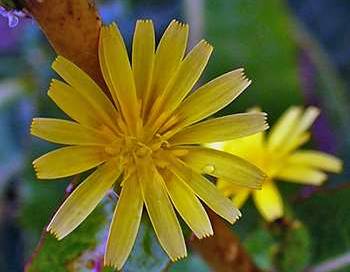

It would be nice to have citations for the clinical studies.
No money in it, who would do the study?
My wild lettuce has a creamy not white sap. Does that sound like something is wrong with it. I have checked several different plants and they are all an off white creamy color. What are your thoughts on that.
The sap is generally white, but can very quickly turn a cream color or even a light shade of brown once exposed to air and sunlight outside the stalk. This is a normal phenomenon and not necessarily indicative of an unhealthy lettuce plant.
Probably you’ve got “Lactuca canadensis” instead… look here https://greatoutdoordinary.com/2017/04/01/wild-edibles-wild-lettuce-lactuca-canadensis/ cheers
This is the first time I’ve heard that it has a 2-year life span. I assume I can harvest leaves and I hope the center section down to about 4 to 6 inches above the ground. If this is wrong, I would appreciate a correction. I have a serious spinal injury from my tail bone up. The 1st through to the 5th vertebrae all have been damaged and I found this plant helped me to sleep for the first time soundly and before falling to sleep, I actually smiled and laughed because I felt NO PAIN. I’ve even told my Physical Therapist and primary care Doctor about this unbelievable wonder plant. All I know is a dear lady who happens to be Native American brought the whole plant, root and all and I planted it until it went to seed. After it went to seed, I planted some in my deck planters for the following year (now) and stored the remaining seeds in a jar in the fridge. I also shared seeds with two others. The stem, root, and leaves were first put in a blender as recommended and then put in water and slowly cooked until it turned dark and syrupy. I used it in my tea using an eyedropper. About 10-12 drops are what I used. Just a little. Store it in a dark even temperature area in a small jar or jars. I will NOT have a home without this plant. I highly recommend it for use as a real pain killer. Just don’t share it with those who won’t use it responsibly. That’s my suggestion. Hope this will help others who are in a similar predicament.
So I made my tincture 4 weeks ago and stuffed the jar, I didnt follow a ratio. Does this mean I need to try a smaller dose at first bc it will be stronger? Also, I touched some of the white stuff to my tongue while making it and felt some weird things and panicked a little, does this mean I’m allergic or that it was too potent in that form?
I bought mine from an Etsy seller, her business name is bossbodyworks. I used the lactuca virosa. I used it for sleep. I was going to make it but was a bit afraid I’d get the ratio’s wrong. Hope that helps. I saw no one responded to you in over a month and I was curious about dosages. She recommended 5 drops from a 5:1 ratio.
I have severe back pain and a neighbor brought me the whole plant she found from a local park. She’s Native American and knows all about this plant. After it went to bloom I harvested it and did the steps without Vodka and I can honestly say it put a smile on my face. NO pain. None at all plus when I went to sleep it was the best rest I had gotten in years. I highly recommend it for people who suffer with pain.
Does anyone sell this?
Can you extract the sap with a juicer effectively?
I do not have access to fresh wild lettuce. I purchased dried but cannot find a recipe for making a tincture using dried wild lettuce. How much would I use for making a cup of tea? My daughter had spinal surgery and I was hoping this would help her with the pain.
While picking wild raspberries a thorn got me but there was a wild lettuce plant right there that I tore a leaf from and applied the sap to the cut. Instant pain killer. Also works on bug bites.
Yes, I agree with topical use. My legs are both neuropathic, meaning I did not know I had stepped into a fire-ant hill until I saw them swarming my sandaled feet. When this fire ant attack happens, I am awakened the following night with pain/intense itch at all the little puss filled blisters.
Thusly injured, I was out harvesting my first crop of wild lettuce and it occurred to me to break a stem of WL and smear it around on my feet, and I have to say, nature never made a better delivery tool for getting between my toes. (Such a cruel place to have those bites). The bites ceased itching and there were many bites that never became those puss filled blisters that go so deep and take so long to heal. I will try again in the future, but this evening I’ll try some tea from sun dried leaves.
I made a highly concentrated extract ball from this plant. I HIGHLY recommend “The Magic Butter Machine” for making herbal meds. It does most of the work for you. Just add plant material & your liquid, cover with lid, choose which preset temperature best suits the needs of what you’re making, then select how long you’ll want it to run. When it’s done, strain liquid from plant material into a labeled jar, & store it in a cool dark place until you need to use it. I sometimes take it a step further, & use the dehydrate option on my air fryer oven to evaporate all the liquid, in which it then becomes shelf stable indefinitely & highly concentrated. I then take some of the concentrate & dilute it for use. That way it doesn’t go bad before it’s all used since some things can go bad quicker than others, especially when using water as your liquid. Liquid of choice plays a major role in potency, pure grain alcohol will get you most potent results. By evaporating all the alcohol off, it doesn’t pose any threat for those whom can not, should not, or choose to avoid it.